How do you blend technology, nature and art — all in one experience?
ARTECHOUSE’s latest exhibit, “Timeless Butterflies” is a visual narrative of a spring bloom, virtually displaying cherry blossoms and butterflies in an immersive, metaverse-like environment. The exhibit, which runs through September 8, shows visuals from “Digital Flower Experiments” by Mei Tamazawa and audio from Matt Lange and Zach Ivans. But building an exhibit like this involves much more than running a few projectors.
At ARTECHOUSE’s DC location (others exist in New York City and Miami Beach), exhibits are broken into two large pieces: a large projection display that anchors the exhibit and smaller supporting pieces that can be more interactive. According to Executive Creative Director Riki Kim, developing an exhibit can take at least two to three months and starts with coming up with an anchoring concept, as well as what they want the main visuals to be. From there, the team will figure out what the experience should feel like, the general visual and audio feel and what special experience they want to add. From there, they’ll determine the layout and what fits physically in the space.
That physical constraint is an important balancing act with the story the team is trying to tell, said Interactive Multimedia Designer Simon Alexander-Adams. Building a display means bridging that gap between the technology that the team has and what they think will connect with the audience.
“We start at this high-level perspective where we’re coming up with, what is the metaphor for this interaction?” Alexander-Adams said. “What are we trying to tell? How does it fit in terms of story or narrative?”
In his work, he primarily uses a Node-based programming language with Python scripting and shader language to build some of the displays. At one time, Kim said, the display can have anywhere from 10 to 15 software running.
For sensory connection, the team members like to use depth cameras to show where people are in the space. For this exhibit, they also had access to LG’s transparent OLED screens in the media lab and put eight of them in a row for a layered look, since visitors can see through them.
After much brainstorming, the team eventually landed on the idea of creating a room-scale instrument, where users can pluck the vines and flowers to make them vibrate like strings as they move through. They also added butterflies that move through the space for a live sense of motion.
“The creative and the technology, I think they’re pretty tethered,” Alexander-Adams said. “They’re intrinsically related, you have to think about them at the same time in my book.”
Joseph Vigorito, the director of technical strategy, said that there can be standard three-chip and single-chip projectors combined with the transparent OLEDs and displays with non-standard aspect ratios and multiple types of cameras.
Each exhibit can be vastly different, he added, as the only thing that’s fixed is the large projection display. The team designs for that environment, while everything else is entirely new each time.
“All of these things are blended and mixed for every single different piece within every exhibition,” Vigorito said. “It’s an ever-growing palette.”

A visitor touches one of the transparent LED screens in the media lab. (Courtesy photo)
As some of the folks at the forefront of art and tech, the team offered some thoughts on where they think the industry is headed next. Kim appreciates that this kind of technology is becoming more well-known, but believes we’re definitely still in the early stages.
“[For audiences] it’s part of the language and appreciation and they’re learning what that piece is like, just like in the beginnings of cinema history,” Kim said. “But at the same time, you have to fight, in a way — what is quality, what isn’t quality, what is the ‘fast food’ of art and what is not the fast food of art.”
As for Vigorito, he said he’s perpetually waiting for hologram technology, like much of the industry. But he also likes the idea that everything can change as technology grows.
“It’s just a time of great exposure for most people because we’re starting to be able to make available all of these different types of technologies on a smaller scale to a wide range of people,” Vigorito said. “That’s really exciting to me because I don’t know what’s going to come out of it, and I think that’s really cool.”

This editorial article is a part of Entertainment Tech Month of Technical.ly’s editorial calendar.
Before you go...
Please consider supporting Technical.ly to keep our independent journalism strong. Unlike most business-focused media outlets, we don’t have a paywall. Instead, we count on your personal and organizational support.
3 ways to support our work:- Contribute to the Journalism Fund. Charitable giving ensures our information remains free and accessible for residents to discover workforce programs and entrepreneurship pathways. This includes philanthropic grants and individual tax-deductible donations from readers like you.
- Use our Preferred Partners. Our directory of vetted providers offers high-quality recommendations for services our readers need, and each referral supports our journalism.
- Use our services. If you need entrepreneurs and tech leaders to buy your services, are seeking technologists to hire or want more professionals to know about your ecosystem, Technical.ly has the biggest and most engaged audience in the mid-Atlantic. We help companies tell their stories and answer big questions to meet and serve our community.
Join our growing Slack community
Join 5,000 tech professionals and entrepreneurs in our community Slack today!

The person charged in the UnitedHealthcare CEO shooting had a ton of tech connections

From rejection to innovation: How I built a tool to beat AI hiring algorithms at their own game

Where are the country’s most vibrant tech and startup communities?




